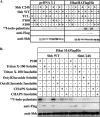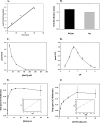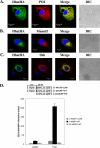Hhat is a palmitoylacyltransferase with specificity for N-palmitoylation of Sonic Hedgehog
- PMID: 18534984
- PMCID: PMC2494920
- DOI: 10.1074/jbc.M803901200
Hhat is a palmitoylacyltransferase with specificity for N-palmitoylation of Sonic Hedgehog
Abstract
Palmitoylation of Sonic Hedgehog (Shh) is critical for effective long- and short-range signaling. Genetic screens uncovered a potential palmitoylacyltransferase (PAT) for Shh, Hhat, but the molecular mechanism of Shh palmitoylation remains unclear. Here, we have developed and exploited an in vitro Shh palmitoylation assay to purify Hhat to homogeneity. We provide direct biochemical evidence that Hhat is a PAT with specificity for attaching palmitate via amide linkage to the N-terminal cysteine of Shh. Other palmitoylated proteins (e.g. PSD95 and Wnt) are not substrates for Hhat, and Porcupine, a putative Wnt PAT, does not palmitoylate Shh. Neither autocleavage nor cholesterol modification is required for Shh palmitoylation. Both the Shh precursor and mature protein are N-palmitoylated by Hhat, and the reaction occurs during passage through the secretory pathway. This study establishes Hhat as a bona fide Shh PAT and serves as a model for understanding how secreted morphogens are modified by distinct PATs.
Figures







References
-
- McMahon, A. P., Ingham, P. W., and Tabin, C. J. (2003) Curr. Top. Dev. Biol. 53 1-114 - PubMed
-
- Fuccillo, M., Joyner, A. L., and Fishell, G. (2006) Nat. Rev. Neurosci. 7 772-783 - PubMed
-
- Ho, K. S., and Scott, M. P. (2002) Curr. Opin. Neurobiol. 12 57-63 - PubMed
-
- Chiang, C., Litingtung, Y., Lee, E., Young, K. E., Corden, J. L., Westphal, H., and Beachy, P. A. (1996) Nature 383 407-413 - PubMed
-
- Roessler, E., Belloni, E., Gaudenz, K., Vargas, F., Scherer, S. W., Tsui, L. C., and Muenke, M. (1997) Hum. Mol. Genet 6 1847-1853 - PubMed
Publication types
MeSH terms
Substances
Grants and funding
LinkOut - more resources
Full Text Sources
Other Literature Sources
Molecular Biology Databases

